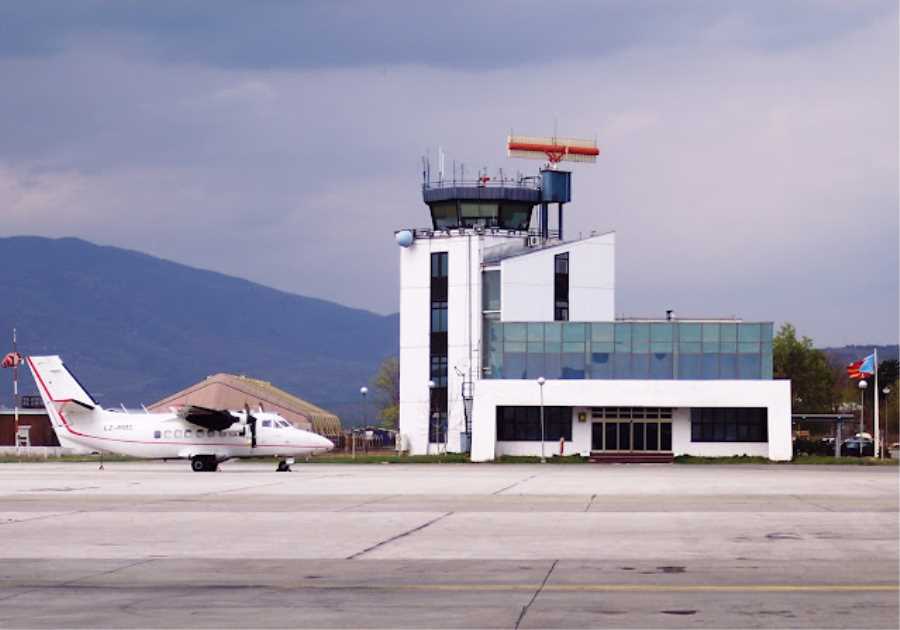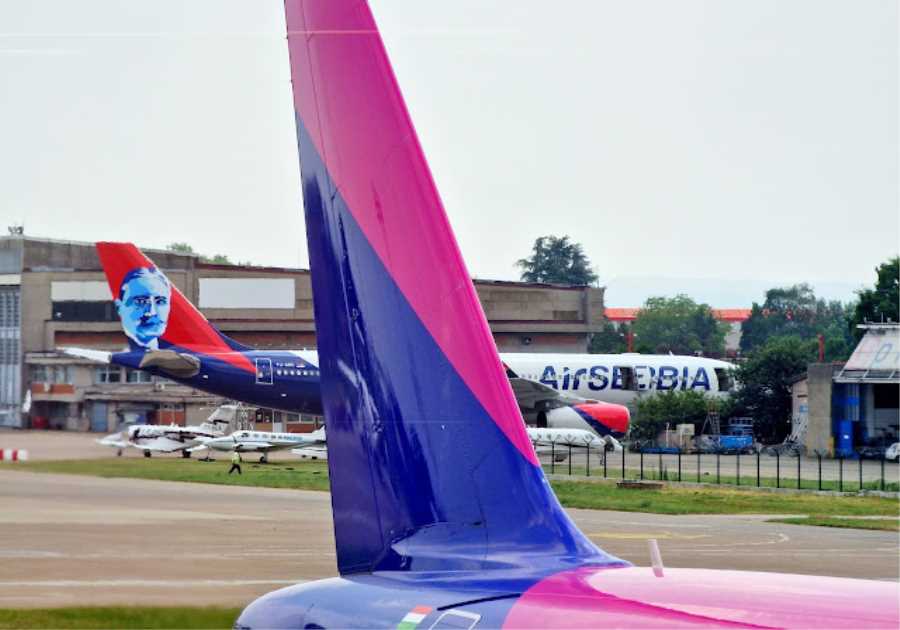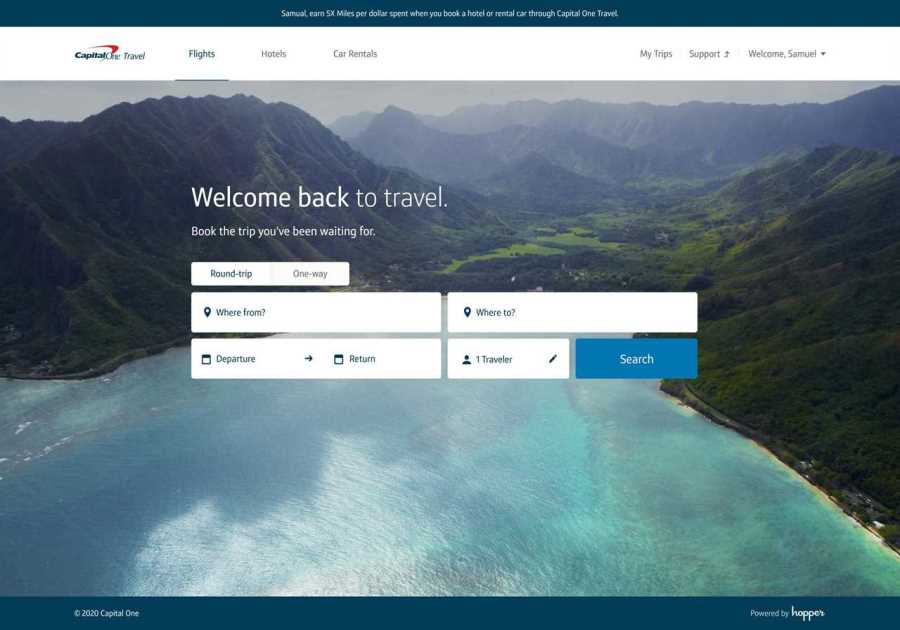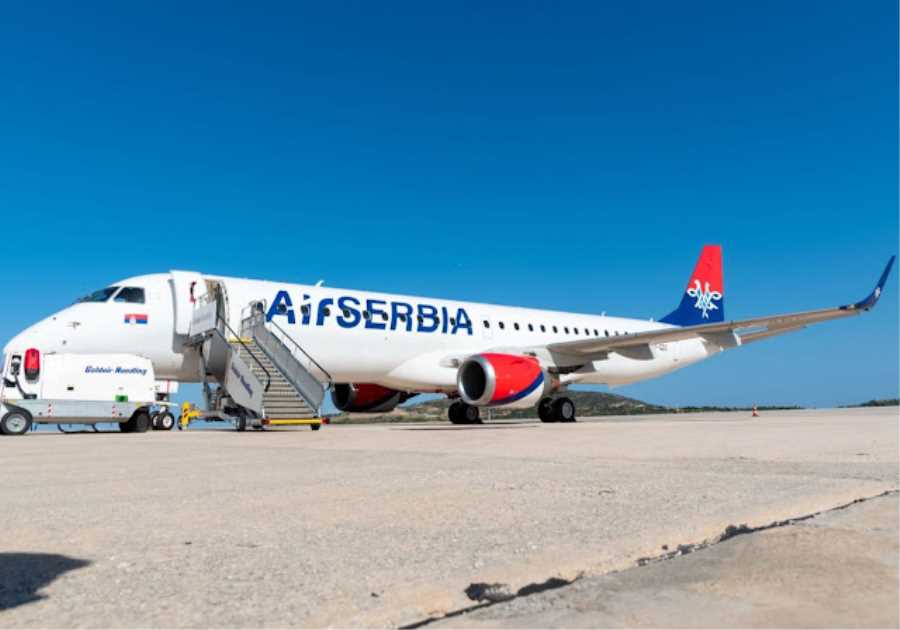HOSTED BY: 1 AIR TRAVEL
Booking premium-cabin flights is one of the most valuable ways to redeem your points and miles. However, you may also see some additional fees, taxes and surcharges payable on top of the quoted mileage when you want to fly upfront.
There are many sources of these added costs. Some are charged by governmental agencies or airport operators at both the origin and destination. Examples include fees that cover U.S. Customs and Border Protection services or the U.K.’s dreaded Air Passenger Duty. The airline then passes these fees on to the passenger.
Related: Quick Points: World of Hyatt members don’t pay any fees or taxes on award stays
Some airlines also impose their own surcharges (on both award bookings and cash tickets). These fees are completely discretionary, and 100% goes to the airline. While some airlines refer to it as a “fuel surcharge,” which is supposed to reflect the cost of the fuel required to transport the passenger on the flight, other programs refer to it as a “carrier-imposed surcharge,” as these added costs are generally independent of fuel expenses.
In other words, it’s free money for the airline.
Some loyalty programs will allow you to redeem more points and miles to cover the cost of the fees, taxes and surcharges. They may also allow you to use even fewer miles than a standard redemption in exchange for a higher cash payment. This can be handy if you have a low mileage balance and cannot book the flight at the standard redemption levels.
But when you are offered a range of payment options, which should you choose? Let’s examine some examples from popular programs to crunch the numbers.
How to make this decision
First, let’s start with a quick overview of how to approach this decision-making process.
Most airline loyalty programs give you a single option: Redeem a fixed number of miles plus a set amount of taxes and fees for a flight. You can then either book the award ticket or pay cash for the itinerary.
However, there are two alternative scenarios offered by some loyalty programs:
Use additional rewards to cover the taxes and fees.Use fewer rewards but pay a copay in cash (plus taxes and fees, which remain fixed).Some even allow both — which can make it even more challenging to identify the option that makes the most sense.
In the first one, you’re redeeming extra miles to keep cash in your pocket. For this scenario, calculate the redemption value of those miles. Take your cash savings and divide it by the extra miles you’re using. If that resulting value is higher than TPG’s valuation for the given currency, that’s a solid option for your rewards.
In the second situation, you’re keeping miles in your account by paying more out of pocket. In other words, you’re paying to keep those miles for a future redemption — which is effectively like purchasing them. Use the same formula — additional cash divided by the points or miles you’re saving — and compare it to TPG’s valuation. But this time, you’re looking for a value that’s lower than our valuation. That’s because you should avoid buying miles for more than they’re worth.
Of course, this may all be irrelevant:
If you’re sitting on a ton of points and miles, you may not care about suboptimal redemption values. In this case, you’re happy to redeem as many rewards as possible to keep the cash in your pocket.If you’re short on points and miles, you may not have any choice. Your account balance may require you to fork over a cash copay. In this case, be sure to look at paid tickets on your route, as you may find it better to just pay for the ticket outright.If this sounds confusing, you’re definitely not alone, so let’s take a look at some concrete examples to show this in action.
ir Canada AeroplanAir Canada Aeroplan is one program that allows you to use additional points to cover the additional cash costs often associated with an award ticket. However, you also have the option of saving points by paying more cash.
For example, let’s say you wanted to book an economy-class ticket from Miami International Airport (MIA) to Frankfurt Airport (FRA) flying on Air Canada using Aeroplan points. The price of an award ticket on a random date is 37,700 Aeroplan points, while the total fees, taxes and surcharges clock in at a reasonable 35.40 Canadian dollars one-way (about $26.50 based on current exchange rates).
However, Aeroplan gives you four different options for paying for this redemption. These options start at using just 22,600 Aeroplan points plus 328.30 Canadian dollars (about $246.50) and go up to 41,240 Aeroplan points with no cash payment.

AIRCANADA.COM
So, which to choose?
If you are flush with many Aeroplan points, you might wish to choose the highest mileage amount for a truly free flight. If you have fewer than 35,000 points in your account, you’ll be forced to choose one of the options with fewer points but more cash to be able to book your flight.
If you are able to select any option, it’s time to do some math — bearing in mind that we value Aeroplan points at 1.5 cents apiece. In both cases, you divide the extra cash by the additional points.
To go from the standard award rate to the zero-cash option, you’d use an extra 3,540 points. This would save you 35.40 Canadian dollars (roughly $26.50). Take $26.50 and divide it by 3,450, which gives you 0.77. You’re thus using those extra points for just 0.77 cents apiece, well below TPG’s valuation.
On the other hand, you have two options for using more cash and fewer points, which is effectively like “buying” them. Here’s how the math works out:
30,100 points + 185.80 Canadian dollars ($139.50): Divide the extra cash you’re spending ($113) by the points you’re saving (7,600). This gives you 1.49, meaning you’re effectively buying points for 1.49 cents apiece.22,600 points + 328.30 Canadian dollars ($246.50): Divide the extra cash ($220) by the points you save (15,100). This gives you 1.46, meaning you’re effectively buying points for 1.46 cents apiece.Both of these figures are close to TPG’s valuation, so they could make sense in certain situations. However, you’d want to avoid going all-in using points.
Related: The best ways to maximize Air Canada’s Aeroplan program
British Airways Executive Club
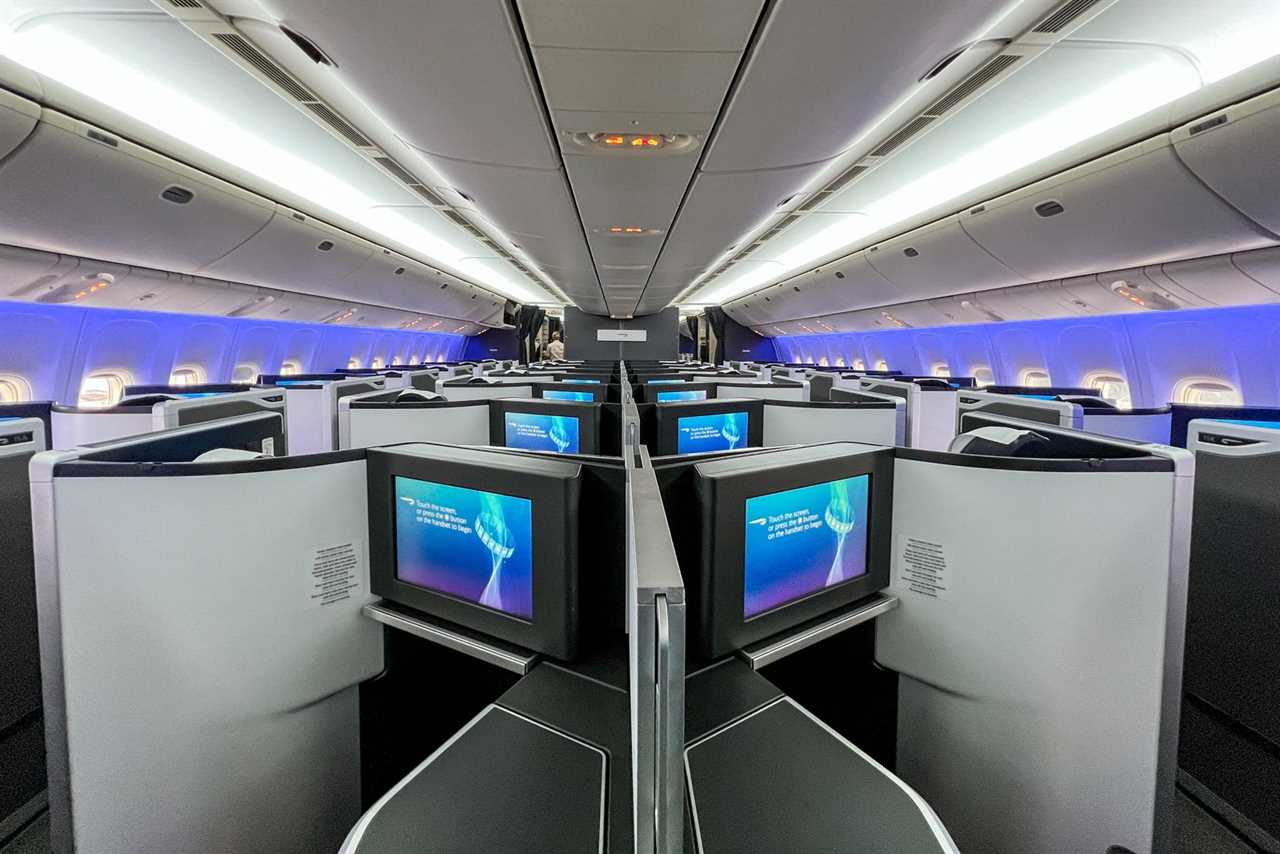
ERIC ROSEN/THE POINTS GUY
British Airways’ Avios program is infamous for its high fuel surcharges on transatlantic redemptions. However, the program gives a wide range of mileage and payment options to considerably reduce surcharges.
A round-trip redemption on British Airways has off-peak pricing of 180,000 Avios plus 450 British pounds ($571) in fees, taxes and surcharges per person, round-trip.
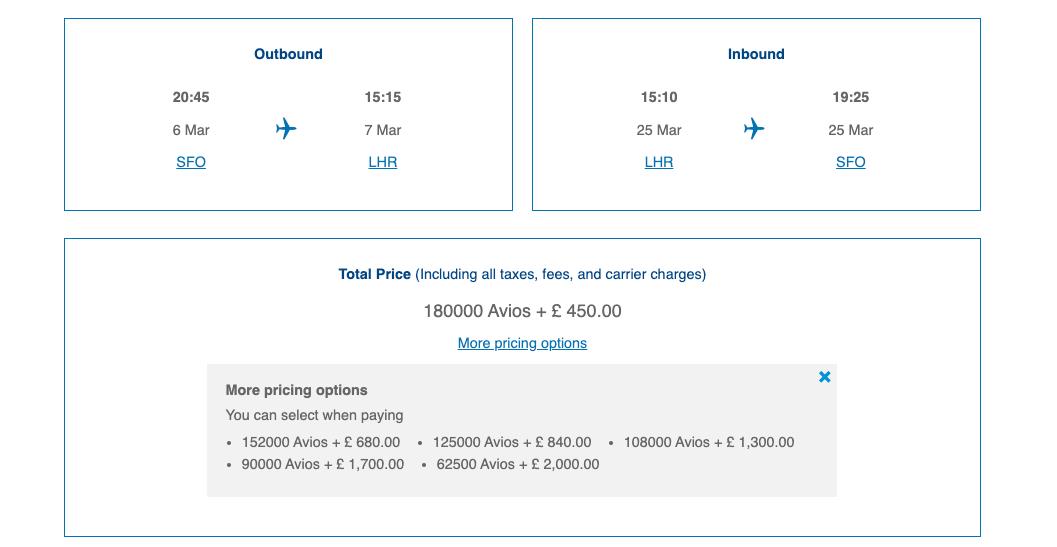
BRITISHAIRWAYS.COM
This is the highest Avios level and lowest cash level British Airways will allow, resulting from BA offering its Reward Flight Saver option on all routes from late last year.
As with the Aeroplan example above, you can crunch the numbers to determine whether forking over extra cash to keep Avios in your account is worth it. Divide this additional cash by the Avios you’re saving. As noted previously, this calculation is effectively like buying Avios — so you’d want to pay less than TPG’s valuation of Avios, which is 1.5 cents apiece.
Here’s how the math breaks down:
152,000 Avios + 680 pounds ($863): Saving 28,000 Avios by paying an extra $292, effectively buying Avios at 1.04 cents apiece125,000 Avios + 840 pounds ($1,006): Saving 55,000 Avios by paying an extra $435, effectively buying Avios at 0.8 cents apiece108,000 Avios + 1,300 pounds ($1,650): Saving 72,000 Avios by paying an extra $1,079, effectively buying Avios at 1.5 cents apiece90,000 Avios + 1,700 pounds ($2,157): Saving 90,000 Avios by paying an extra $1,586, effectively buying Avios at 1.76 cents apiece62,500 Avios + 2,000 pounds ($2,538): Saving 117,500 Avios by paying an extra $1,967, effectively buying Avios at 1.67 cents apieceThe first two options could make sense given the effective purchase price falling well below TPG’s valuation. Meanwhile, the middle option is essentially a break-even proposition, while the last two should be avoided.
Of course, all of these options still require a significant outlay of cash. And at the high range of those prices, it’s worth checking cash fares on the same dates, as you might find alternate options for similar pricing. You’d then earn points and miles for the paid tickets, while you would not earn on an award booking.

GOOGLEFLIGHTS.COM
Related: Is it better to redeem Avios through British Airways Executive Club or Qatar Airways Privilege Club?
Bottom line
Fees, taxes and surcharges are an unfortunate reality of redeeming points and miles for flights. For some programs, these are only a few dollars. In contrast, if you fly a carrier that imposes fuel surcharges, you might end up paying several hundred dollars for long-haul premium-cabin flights.
It’s great that some programs give you the option of paying more points and miles to reduce the cash component required, sometimes down to zero. Meanwhile, others allow you to pay additional cash to lower the number of rewards you’d need to use.
The best-value sweet spot is usually in the middle of the range, where you pay the full fees, taxes and surcharges in cash and the normal mileage required in points and miles.
Title: Should you use more rewards to pay the taxes and fees on your next redemption?
Sourced From: thepointsguy.com/guide/use-points-and-miles-taxes-and-fees/
Published Date: Wed, 02 Aug 2023 19:30:13 +0000
Did you miss our previous article...
https://1airtravel.com/pass/want-to-hit-bucket-list-destinations-in-antarctica-and-the-pacific-this-luxury-cruise-line-now-has-a-2nd-expedition-ship


